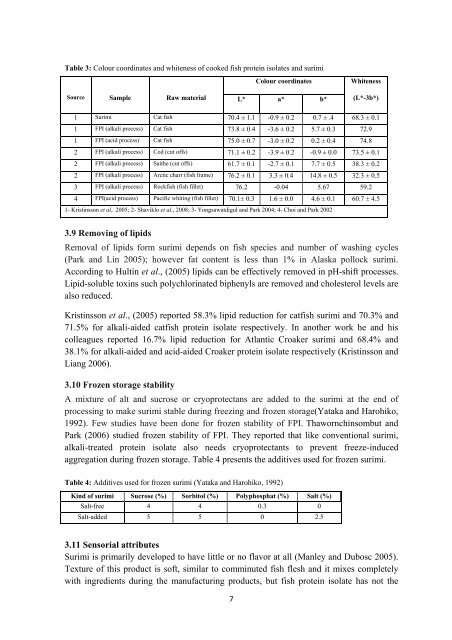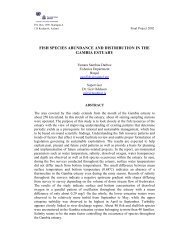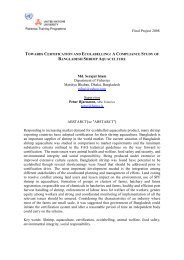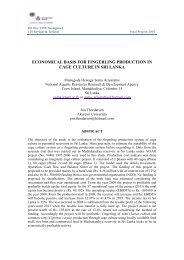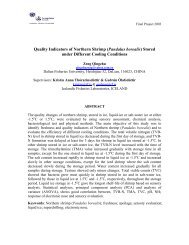Evaluation and Utilisation of Fish Protein Isolate Products
Evaluation and Utilisation of Fish Protein Isolate Products
Evaluation and Utilisation of Fish Protein Isolate Products
- No tags were found...
Create successful ePaper yourself
Turn your PDF publications into a flip-book with our unique Google optimized e-Paper software.
Table 3: Colour coordinates <strong>and</strong> whiteness <strong>of</strong> cooked fish protein isolates <strong>and</strong> surimiSource Sample Raw materialColour coordinatesL* a* b*Whiteness(L*-3b*)1 Surimi Cat fish 70.4 ± 1.1 -0.9 ± 0.2 0.7 ± .4 68.3 ± 0.11 FPI (alkali process) Cat fish 73.8 ± 0.4 -3.6 ± 0.2 5.7 ± 0.3 72.91 FPI (acid process) Cat fish 75.0 ± 0.7 -3.0 ± 0.2 0.2 ± 0.4 74.82 FPI (alkali process) Cod (cut <strong>of</strong>fs) 71.1 ± 0.2 -3.9 ± 0.2 -0.9 ± 0.0 73.5 ± 0.12 FPI (alkali process) Saithe (cut <strong>of</strong>fs) 61.7 ± 0.1 -2.7 ± 0.1 7.7 ± 0.5 38.3 ± 0.22 FPI (alkali process) Arctic charr (fish frame) 76.2 ± 0.1 3.3 ± 0.4 14.8 ± 0.5 32.3 ± 0.53 FPI (alkali process) Rockfish (fish fillet) 76.2 -0.04 5.67 59.24 FPI(acid process) Pacific whiting (fish fillet) 70.1± 0.3 1.6 ± 0.0 4.6 ± 0.1 60.7 ± 4.51- Kristinsson et al,. 2005; 2- Shaviklo et al., 2008; 3- Yongsawatdigul <strong>and</strong> Park 2004; 4- Choi <strong>and</strong> Park 20023.9 Removing <strong>of</strong> lipidsRemoval <strong>of</strong> lipids form surimi depends on fish species <strong>and</strong> number <strong>of</strong> washing cycles(Park <strong>and</strong> Lin 2005); however fat content is less than 1% in Alaska pollock surimi.According to Hultin et al., (2005) lipids can be effectively removed in pH-shift processes.Lipid-soluble toxins such polychlorinated biphenyls are removed <strong>and</strong> cholesterol levels arealso reduced.Kristinsson et al., (2005) reported 58.3% lipid reduction for catfish surimi <strong>and</strong> 70.3% <strong>and</strong>71.5% for alkali-aided catfish protein isolate respectively. In another work he <strong>and</strong> hiscolleagues reported 16.7% lipid reduction for Atlantic Croaker surimi <strong>and</strong> 68.4% <strong>and</strong>38.1% for alkali-aided <strong>and</strong> acid-aided Croaker protein isolate respectively (Kristinsson <strong>and</strong>Liang 2006).3.10 Frozen storage stabilityA mixture <strong>of</strong> alt <strong>and</strong> sucrose or cryoprotectans are added to the surimi at the end <strong>of</strong>processing to make surimi stable during freezing <strong>and</strong> frozen storage(Yataka <strong>and</strong> Harohiko,1992). Few studies have been done for frozen stability <strong>of</strong> FPI. Thawornchinsombut <strong>and</strong>Park (2006) studied frozen stability <strong>of</strong> FPI. They reported that like conventional surimi,alkali-treated protein isolate also needs cryoprotectants to prevent freeze-inducedaggregation during frozen storage. Table 4 presents the additives used for frozen surimi.Table 4: Additives used for frozen surimi (Yataka <strong>and</strong> Harohiko, 1992)Kind <strong>of</strong> surimi Sucrose (%) Sorbitol (%) Polyphosphat (%) Salt (%)Salt-free 4 4 0.3 0Salt-added 5 5 0 2.53.11 Sensorial attributesSurimi is primarily developed to have little or no flavor at all (Manley <strong>and</strong> Dubosc 2005).Texture <strong>of</strong> this product is s<strong>of</strong>t, similar to comminuted fish flesh <strong>and</strong> it mixes completelywith ingredients during the manufacturing products, but fish protein isolate has not the7


